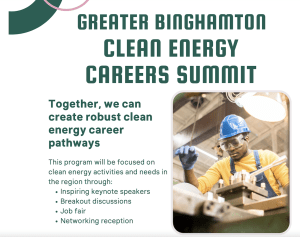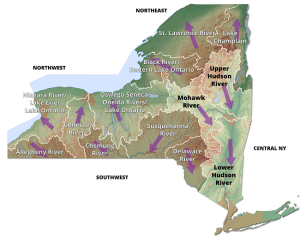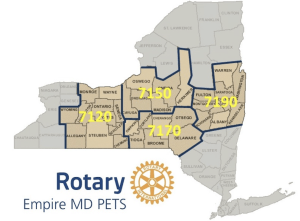By PDG Jeff Smith, District 7170 Environmental Sustainability Chair
Rotary’s Seventh Area of Focus is an enormous undertaking. According to Bill Gates, in his recent book How to Avoid a Climate Disaster, the transition to net zero carbon emissions will be the greatest challenge the world has ever faced. To make meaningful progress, Rotary will collaborate within and beyond Rotary for knowledge, impact and funding.
The Upstate New York region served by D 7170 and other districts was once a center of technology development. Now, the focus on clean energy technology, chip manufacturing, and nanotechnology opens the potential for vast development that can help build organizations like Rotary. To get there we need to develop the workforce and address our level of poverty.

Flyer from the upcoming regional clean energy summit in Binghamton, New York
Rotary District 7170’s environmental sustainability strategy also embraces economic development, community well-being, partnerships, funding, increased membership, and a sense of urgency. We update our plan every June 5, World Environment Day. Some of the issues we need to address for the next update include:
- The US Federal Government passed the Inflation Reduction Act (IRA) in 2022, providing new incentives for electric vehicles and clean energy technology projects. The website of the nonprofit organization Re-Wiring America provides information and a calculator for the IRA benefits. We’re exploring what we can do to assure that this funding flows to our district and supports our projects and communities.
- The Federal Defense Act promotes development of local manufacturers of heat pumps. How can we work with our communities to attract a manufacturer to our district?
- The Federal CHIPS Act provides funding for STEM [Science, Technology, Engineering, and Math] career training. Our region needs a stronger regional STEM Hub to provide the necessary jobs for clean energy manufacturing and the services required to comply with New York State’s climate goals. How can Rotary members use their vocational skills to strengthen STEM and attract funding?
- Brian Braginton-Smith of ESRAG and the Cape Cod Watershed Institute has developed a connected communities plan for part of Cape Cod that achieves net zero emissions. The program features the design of a net zero school. The project has won the interest of the US Departments of Energy and of Agriculture. Can our district apply Brian’s work locally and begin to scale Rotary environmental focus from Boston to Buffalo?
- A local support group has developed a plan for a nationally-rated water trail on the Susquehanna Watershed, from Cooperstown to the Finger Lakes. Several Rotary clubs and two districts have provided letters of support for the project to secure funding from the National Park Service. The Susquehanna is a one of the five oldest rivers in the world. In addition to protecting the river, we want it to be a recreational area.
- State and local policies also open great opportunities for Rotarians. I’ve been updating our District on New York’s climate plan under the Climate Leadership and Community Protection Act (CLCPA). The CLCPA has a major focus on climate justice and under-served communities.
- The Ithaca Green New Deal goes beyond the State in this regard, and has already developed a Green Jobs Corridor to focus on training of under-served communities in a broad region comprising the Southern Tier, Greater Rochester and Greater Syracuse. I represent Rotary, Tier Energy Network and other organizations in a large collaboration on this project. We are seeking funding together.
- A Binghamton University-led proposal recently won $113 million in State and Federal funding for “New Energy NY,” a five-part program to improve the US supply chain for the battery industry. The award provides $5 million for climate justice and $25 million for workforce development with a major focus on under-served populations. The key positions for this program are being filled now.
In the meantime, a local collaboration is working on a pilot project in Broome County. We are in the process of interviewing every organization and business involved in workforce development and under-served communities. This is a powerful way to understand the needs of our communities. We run into Rotary members that work on DEI as part of their jobs. This week we interviewed Nikki Post, Executive Director of the Southern Tier Community Center. Nikki is a member of Endicott Rotary and the broad-based collaboration Endicott Proud.
The most recent development is a Clean Energy Career Path Summit to be held in each region of New York State. Our collaboration is supporting this effort and our regional summit will be held on May 2 in Binghamton. The summit will include a job fair and expo. Rotarians who attend will be able to meet many employers and service providers who can assist job seekers. There will also be a schedule of workforce-related projects and events for the remainder of the year.
The three districts forming Central NY Rotary are planning a joint district conference at the Thousand Islands Harbor Hotel, May 5 through 7. I have been asked to do a 20-minute presentation on watersheds on Saturday morning. Our region is blessed with watersheds: the Great Lakes, the Finger Lakes, and the Susquehanna, Delaware, and Hudson Rivers. Our districts’ approach is holistic: protecting our natural assets and biodiversity and tackling the climate challenge. We are also interested in community development projects, like the proposed Susquehanna NY Water Trail project that stretches 190 miles from Cooperstown to the Finger Lakes.
We should be able to fill 20 minutes at that conference.

New York watersheds

Four Rotary districts that partner for President-Elect Training
Rotary has proved its staying power through the campaign to end polio. When Rotarians undertake to protect our natural assets and biodiversity and meet the climate challenge, we’re launching a new, decades-long initiative of critical importance. When we expand the scope to include entire water systems like the Chesapeake watershed, that creates a holistic model that can replicated by Rotary for watersheds around the world.

Jeff Smith, PDG of D7171, is “retired” from his career but working nonstop to catalyze an environmental and economic revival of his state and region.
Rotary is going to need to attract significant funding to play the role they want to play. In large measure Rotary can be the facilitator.
This winter the Washington Post cited US Bureau of Labor Statistics that the United States has a huge demand for workers to make batteries, build wind and solar farms, and electrify transportation and buildings. Construction and manufacturing sectors were short almost 1.2 million workers, and the Bureau estimated there will be about 80,000 job openings for electricians every year till 2031.
